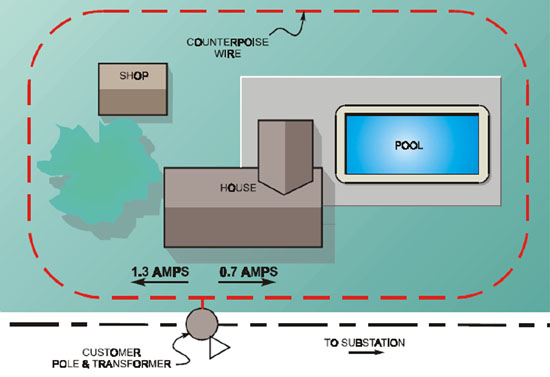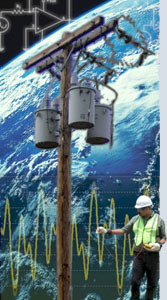Swimming Pool Deck Shocking
Shelby, North Carolina, USA
Background
The owner of a home was concerned about the safety of her grandchildren when they were in her swimming pool. The grandchildren were getting shocked on the sides of the pool. The pool had a concrete deck.
The owner had inquired about this shocking voltage in the summer of 1992. In that year, the utility installed an underground counterpoise wire from the transformer pole around her house and pool and back to the transformer pole, as shown in Figure 1.
 |
| Figure 1: Installation of a Counterpoise Wire |
The installation of the underground counterpoise wire appeared to have solved the shocking problem until 1988.
Possible Causes
The initial investigation considered several possibilities:
- Faulty wiring on the owner's side.
- Open or damaged system neutral.
Action Taken
The possible causes were ruled out by:
- Temporarily de-energizing the owner's wiring by pulling the power meter.
- Inspecting the system neutral because the area where the owner's home was located is subject to tree-related damage.
The next step in the investigation was to measure the shocking voltage and to check for proper bonding at the swimming pool. The shocking voltage was measured at 2.75 VAC from the pool's water to the wet concrete deck. The swimming pool's concrete deck and coping stone were not bonded. The owner was informed of the lack of bonding for the deck and coping stone.
The next step was to take current readings and neutral-to-earth voltage (NEV) voltage measurements on the circuit. The decreasing NEV values indicate that the shocking voltage was related to the load. The results are shown in Table 1. The current readings and NEV measurements indicate that the shocking voltage was a function of load on the long single-phase line.
 |
| Table 1: Measurements Taken at a Point on the Single-Phase Circuit |
Solutions
The solution to the owner's shocking voltage was to bond the swimming pool's concrete deck and coping stone. Also, one section of the single-phase circuit should be open-wyed or three-phased to reduce the current because the shocking voltage was widespread.

